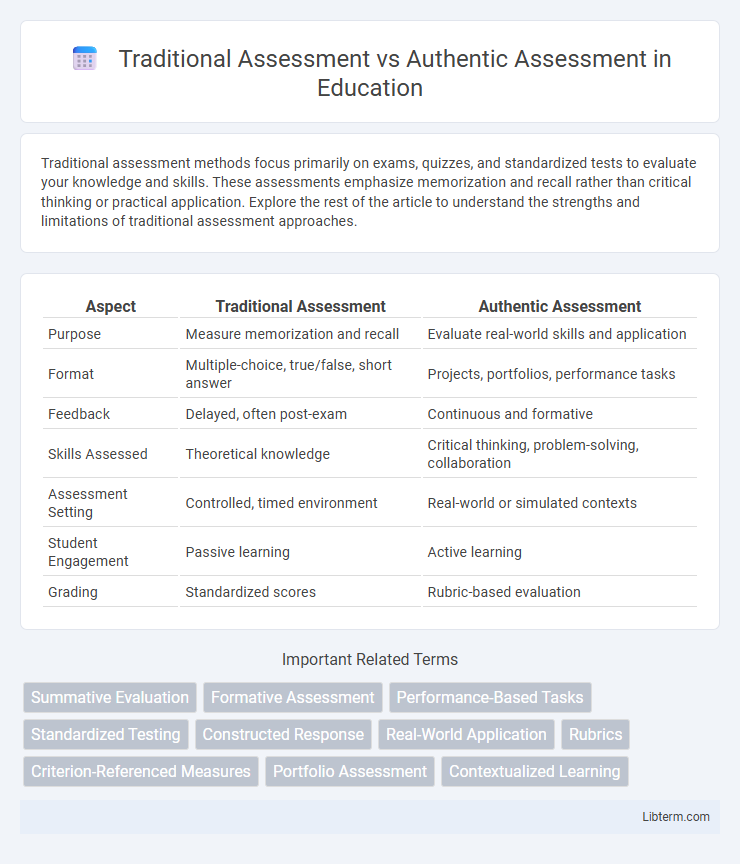Traditional assessment methods focus primarily on exams, quizzes, and standardized tests to evaluate your knowledge and skills. These assessments emphasize memorization and recall rather than critical thinking or practical application. Explore the rest of the article to understand the strengths and limitations of traditional assessment approaches.
Table of Comparison
| Aspect | Traditional Assessment | Authentic Assessment |
|---|---|---|
| Purpose | Measure memorization and recall | Evaluate real-world skills and application |
| Format | Multiple-choice, true/false, short answer | Projects, portfolios, performance tasks |
| Feedback | Delayed, often post-exam | Continuous and formative |
| Skills Assessed | Theoretical knowledge | Critical thinking, problem-solving, collaboration |
| Assessment Setting | Controlled, timed environment | Real-world or simulated contexts |
| Student Engagement | Passive learning | Active learning |
| Grading | Standardized scores | Rubric-based evaluation |
Introduction to Assessment Methods
Traditional assessment methods emphasize standardized testing formats such as multiple-choice, true/false, and short-answer questions that primarily measure rote memorization and factual recall. Authentic assessment evaluates students through real-world tasks and projects that demonstrate practical application, critical thinking, and problem-solving skills. These contrasting approaches highlight the shift from purely quantitative evaluation to more qualitative, competency-based assessment models in education.
Defining Traditional Assessment
Traditional assessment refers to standardized testing methods such as multiple-choice, true/false, and short-answer questions designed to evaluate students' recall and understanding of specific content. It emphasizes objective scoring and often measures academic achievement through timed exams and quizzes. This form of assessment typically prioritizes memorization and the ability to reproduce knowledge under controlled conditions.
Defining Authentic Assessment
Authentic assessment evaluates students' ability to apply knowledge and skills in real-world contexts, emphasizing practical tasks that mirror professional and everyday challenges. Unlike traditional assessments, which often rely on standardized tests measuring rote memorization, authentic assessments involve portfolio creation, performance tasks, and collaborative projects that foster critical thinking and problem-solving. This approach provides a comprehensive understanding of student learning by integrating meaningful, context-driven evaluation methods.
Key Differences Between Traditional and Authentic Assessment
Traditional assessment primarily measures rote memorization and standardized test performance through multiple-choice, true/false, and short-answer questions, whereas authentic assessment evaluates students' practical application of knowledge via real-world tasks, projects, and portfolios. The key difference lies in how traditional assessments prioritize content recall under timed conditions, while authentic assessments emphasize critical thinking, problem-solving, and the ability to demonstrate skills in context. Furthermore, authentic assessments provide ongoing feedback and reflect holistic understanding, contrasting with traditional assessments' reliance on summative scores for grading.
Advantages of Traditional Assessment
Traditional assessment provides clear, standardized criteria that facilitate objective grading and comparison across large groups of students. Its structured format allows for efficient administration and scoring, often using multiple-choice or short-answer questions that yield quantifiable results. These assessments are effective for measuring specific knowledge and recall abilities, supporting reliability and consistency in evaluating student performance.
Benefits of Authentic Assessment
Authentic assessment provides real-world relevance by evaluating students' abilities to apply knowledge and skills in practical scenarios, enhancing critical thinking and problem-solving competencies. It promotes deeper learning and student engagement by encouraging active participation and reflection, leading to improved retention and meaningful understanding. Furthermore, authentic assessment supports diverse learning styles and offers more comprehensive feedback, facilitating personalized instruction and skill development.
Challenges of Implementing Authentic Assessment
Implementing authentic assessment presents challenges such as increased time consumption for educators in designing complex, real-world tasks that accurately measure student competencies. It often requires extensive professional development and resources to ensure consistency and reliability in evaluation across diverse learning environments. Furthermore, aligning authentic assessments with standardized curriculum standards while maintaining meaningful, contextual learning experiences remains a significant hurdle for educational institutions.
Examples of Traditional vs Authentic Assessment
Traditional assessment examples include multiple-choice tests and true/false quizzes that measure rote memorization and factual recall. Authentic assessments feature real-world tasks like project-based learning, portfolios, and performance tasks that evaluate critical thinking, problem-solving, and application of knowledge. These authentic methods emphasize practical skills and deeper understanding compared to traditional standardized exams.
Impact on Student Learning and Engagement
Traditional assessment primarily measures rote memorization and factual recall, often limiting deeper critical thinking and problem-solving skills, which can reduce student engagement. Authentic assessment emphasizes real-world tasks that foster higher-order thinking, collaboration, and practical application, leading to increased motivation and meaningful learning experiences. Research shows students participating in authentic assessments demonstrate improved retention, creativity, and active involvement compared to those assessed through traditional methods.
Choosing the Right Assessment Approach
Choosing the right assessment approach depends on the learning objectives and skill types being evaluated; traditional assessments, such as multiple-choice tests, effectively measure factual knowledge and standardized skills with ease of grading. Authentic assessments prioritize real-world application and critical thinking through performance tasks, portfolios, or projects that demonstrate student competence in practical contexts. Selecting between these approaches requires balancing reliability, validity, and alignment with instructional goals to ensure meaningful evaluation of learner outcomes.
Traditional Assessment Infographic

 libterm.com
libterm.com